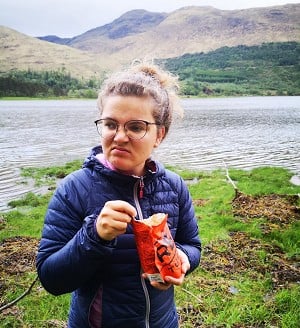
A small company based in Bangor, TentMeals was dreamed up by its founder Jess Szekely during a gruelling (and poorly-fed) cycle trip across Alaska. The best restaurants tend not to have an over-packed menu, and in the spirit of keeping things commendably simple TentMeals offer a limited range of nosh - dinner, breakfast and trail snacks - with an emphasis on healthy, all-natural ingredients, and on squeezing a lot of calories into very tiny packets.
All the meals are vegan - which some will welcome, since vegan options are often quite limited. As a non-veggy with no dietary restrictions I have to admit I've missed a bit of cheese or butter, and out of habit I've been supplementing the protein (and fun) intake with biltong. But most of us do eat too much meat, so on balance I'm all for the TentMeals approach.
Unlike those convenient dehydrated camping pouches designed to pour hot water into and eat straight out of, thus saving washing up, TentMeals come in the smallest and most densely-packed of vacuum packs. Packaging weighs an average of just 4g, which I'm sure is a lot less than many rivals. This is fantastic for rucksack space, and good news if you're trying to reduce waste, but on the downside you'll need to mix the food in your cooking pot or bring a bowl, which means washing up after every meal. For backpackers that's probably only a wee bit of a pain, but if you're mountaineering it's not always going to be a practical possibility - something worth bearing in mind.
You'll also need a knife or nail scissors to get into the packaging, which is very tough and non-perforated. Again there is an advantage to this, namely that you could chuck a load of these meals into a kit bag for an expedition and be fairly confident they'd remain undamaged.
What do you get and what do they cost?
If you're stocking up on packable camping or expedition food on a budget, and not up for DIYing your own dehydrated fare from scratch, then step this way.
Main meals come in 500kcal or 800kcal portions, and naturally I went for the bigger ones. Given how expensive some freeze-dried camp pouches are these days, the prices - just £5.90 or £6.90 depending on calorie count - are nothing short of brilliant value. You could easily fork out twice that much dough for another brand, and I think you'd struggle to find dehydrated grub matching TentMeals prices.
Breakfasts are also either 500kcal or 800kcal (!!) apiece, ranging in price from £5.50 to £5.90. With these I stuck to 500kcal, since 800 would be insane unless you were hauling a sledge across some ice cap. A breakfast of porridge usually leaves me running on empty with hunger pangs by mid morning, but no danger of that with any of the following.
Breakfast
We'll start with the morning fare, because breakfast is the building block of your day (see Dad, I did listen) and I think generally the more successful part of the TentMeals offering.
Dour Scottish traditionalists who take their oats with a weak-willed pinch of salt might baulk at the TentMeals posh-porridge range, with its added fruit and seeds, and the indulgence of distinctive flavours, but I've (largely) enjoyed them as a morning treat on the hill, packed with both taste and nutrition.
Yes it's only oats, seeds, coconut and dried fruit, and you could always make your own from scratch - but could you vacuum pack it into calorie-controlled portions? As far as I'm concerned, no; and that makes (most of) these a big hit...
Subtly Cinnamon breakfast
A flavoured porridge giving you a whopping 500kcal for a packed weight of just 116g, this is a mighty morning calorie hit.
The instructions say 100-130ml of boiling water, which is a lot less than some of the other breakfast packs, and I decided that was an underestimate. As per all the others too, you can also make it cold if it's left overnight; but is anything more hair-shirt than cold porridge?
This is a very tasty breakfast with a lovely blend of cinnamon, ginger and lemon - neither too subtle, nor overpowering. The addition of some raw cane sugar probably helps a lot. Pears, dates and walnuts provide added texture, nutrition and bursts of flavour, and that would have been great but for what looked like half a dried pear that I unearthed in my bowl, which really ought to have been chopped into much smaller bits.
Blueberry Burst Breakfast
Another porridge-based offering, Blueberry Burst is 500kcal of oaty goodness at a packed weight of just 127g.
It reconstitutes well in the allotted time of seven minutes, but I've found it needs a bit more than the suggested 250-320ml of boiling water to attain a nice spoonable porridge texture.
With hits of blueberry, cranberry, coconut and the occasional lemony zing, there's a fresh and fruity flavour that works perfectly with your morning coffee. It's a huge portion compared to my usual - and I'm not a light breakfast type of person - which at a pinch could be enough for two; anyone able to consume an 800 calorie portion gets my respect.
Sour Cherry & Chocolate Breakfast
With 500kcal at just 116g, this is one of the winners on energy:weight, though in other respects it's my least favourite of the breakfasts.
The seven-minute quoted reconstituting time seems about right, but I found it necessary to add a wee bit more boiling water than the instructed 150-200ml in order to achieve something that the spoon didn't stand straight up in.
An off-brown sludge with chunks of dark cherry like rabbit poos, this looks the least appetizing of the morning fare. It's described as a 'multi grain porridge', so along with the oats you get a lot of different grains, seeds, dried fruit and nuts. Sounds interesting, but in fact I find it too diverse and would prefer more oats and fewer sundry extras.
The key flavour profile of cherry and chocolate isn't too bad, though perhaps more suited to an after dinner dessert than my usual breakfasts, but soapy hints from the coconut spoil it for me, and this is one bowlful that I actually had to make myself finish. No question it'll keep you fuelled for the morning though; and regular.
Dinners
Given their compact size and light weight, you get a lot of calories and nutrition in a TentMeals dinner. Compared with many another pricey freeze-dried alternative they squeeze in a lot of energy per pound spent, too. Yet for me this is the weaker half of the TentMeals range in terms of both taste and texture, both of which are also important considerations for most eaters.
Thai Green Curry main meal
Packing 800kcal in just 170g dry weight, this blend of rice, dehydrated veg and cashews has the best energy-to-weight ratio in the range, and if you're carrying multiple days or weeks worth then the weight saving would add up. If food is simply fuel then it's a winner, but from an enjoyment perspective I'm not sold on this recipe.
As instructed, I added it to 250ml of boiling water, stirred, covered and left to stand. After the allotted 10 minutes it was still distinctly un-rehydrated. I added a splash more hot water and left it for another five minutes; still not ready. By now of course it was stone cold, so it was back on the stove, with more water and plenty of stirring, not just to bring it back up to temperature but to actually cook it a bit longer. After getting on for 20 minutes in total the rice grains did feel properly rehydrated and cooked, but some of the veg - I think it was the peas - remained completely hard and dry.
Proof of the dinner is in the eating. The overall texture was stodge with a crunch, but it was the flavour that made it hard work to finish (and I was hungry): Bland as baby food, yet with a bitter tang suggesting under-cooked spices. Really not a winner, and could do with more of everything - salt, fat, joy...
Italian Inspired main meal
Giving you 800kcal in 202g, this main course is a couscous and tomato based offering, with added nuts, veg and 'parmesan style shavings'. I'm not sure whether it might actually be more Moroccan-influenced really, but TentMeals do one of those too, and either way it's a hearty dinner that's filling without being stodgy.
The couscous reconstitutes quickly, as you'd expect, and I found it didn't need extra water and cooking to get to a decent texture. In terms of flavour I would call it workmanlike rather than inspiring, and while I did find it miles more palatable than the Thai curry I felt it could do with more oomph and sophistication in terms of the spice profile (paprika and Italian herbs don't quite cut it alone). More salt, and some oil would not go amiss too - it's a bit worthy for me, and I live in a largely veggy household where kale and brown rice are considered dinner.
Almond Jalfrezi main meal
At 800kcal and just 178g, this mild curry of rice, almonds, onion and coconut is a lot of dinner for not a lot of weight. It reconstitutes well in the required 10 minutes, though it'll be lukewarm at best by the time you eat it. Luckily in this case I didn't find that mattered.
With a good texture - not too cloying - this is my favourite of the dinners, a tasty and satisfying meal that I would choose to buy again. The curry spices are aromatic without being overpowering, there's plenty of rice to fill you up, and I love the hearty crunch from the almonds. As with other meals the raw coconut flakes are a little soapy, but I can forgive that in this case since the rest is genuinely nice.
Moroccan main meal
With this one your 800kcal weighs 204g, making it marginally the heaviest meal for the calorie count - probably only a concern for the most committed lightweight backpackers or teams on a long expedition. It's another couscous-based dinner, with a load of dried fruit - mango, raisins and apricots - plus sunflower seeds and walnuts for protein.
I'll happily eat it, and it does the job nutritionally; but I can't say it's exciting. You can't go wrong with couscous in terms of texture. But to me it seems the spice mix is simultaneously over-perfumed, yet bland; and if that doesn't quite make sense, then let's say it's all top-note and no bass. And it's another one that could benefit from some salt and fat.


















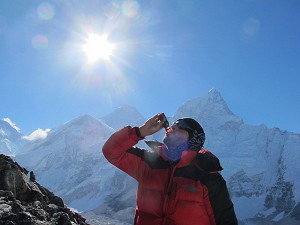



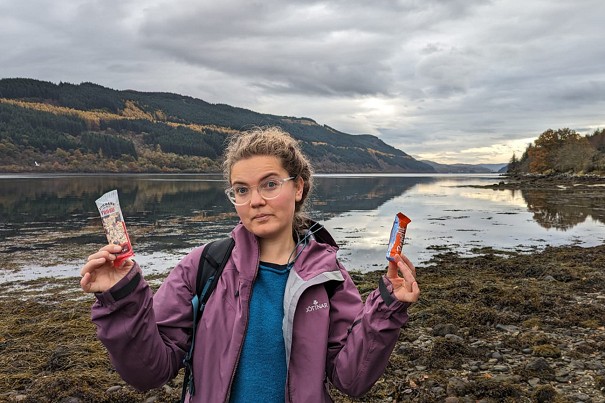






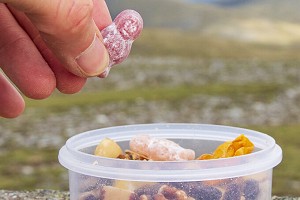
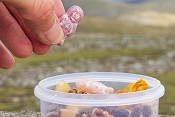


Comments
If your meals were lukewarm after rehydrating, it begs the question of whether you were using a cosy? My experience of rehydrating meals is that they are still almost too hot, when using a two-layer reflectix cosy. The maintained temperature also encourages rehydration, as does having sufficient water (which also keeps the temperature up: you're adding more energy).
Short answer - no. I've made a bottle cosy out of foil bubble wrap in the past but not used one for camp dinners
So like the other awful expedition foods but worse?
A cosy does, of course, take up extra space in a pack, but I use a 'russian dolls' nesting setup, where the stove fits inside the pan, the pan fits inside the rehydration/eating pot, and the pot fits inside the cosy. So quite space efficient, as well as fuel efficient.
There's a recycled 300ml buttermilk pot & lid in there, too, that has a handy 50ml graduated scale on the side. Used for measuring water and as a cup. Inside that is the meths burner, lighter & little fuel measuring cup...
Nice